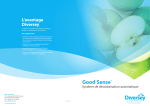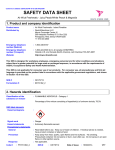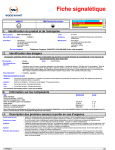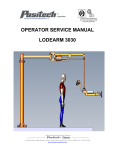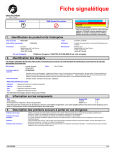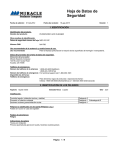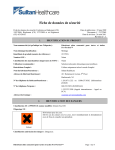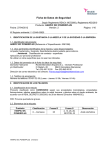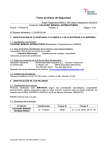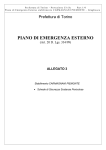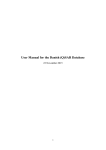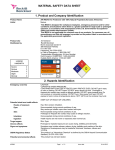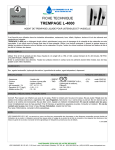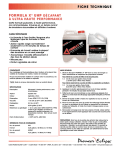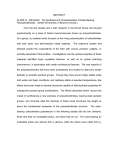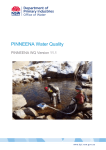Download SAFETY DATA SHEET - E
Transcript
Conforms to USDOL OSHA 29CFR 1910.1200 HAZCOM SAFETY DATA SHEET Lysol Brand Kills 99.9% of Viruses & Bacteria Power & Free Multi-Purpose Cleaner with Hydrogen Peroxide, All Scents 1. Product and company identification Product name Distributed by : Lysol Brand Kills 99.9% of Viruses & Bacteria Power & Free Multi-Purpose Cleaner with Hydrogen Peroxide, All Scents : Reckitt Benckiser LLC. Morris Corporate Center IV 399 Interpace Parkway (P.O. Box 225) Parsippany, New Jersey 07054-0225 +1 973 404 2600 Emergency telephone number (Medical) : 1-800-338-6167 Emergency telephone number (Transport) Website: : 1-800-424-9300 (U.S. & Canada) CHEMTREC Outside U.S. and Canada (North America), call Chemtrec:703-527-3887 Product use : Multipurpose Cleaner : http://www.rbnainfo.com This SDS is designed for workplace employees, emergency personnel and for other conditions and situations where there is greater potential for large-scale or prolonged exposure, in accordance with the requirements of USDOL Occupational Safety and Health Administration. This SDS is not applicable for consumer use of our products. For consumer use, all precautionary and first aid language is provided on the product label in accordance with the applicable government regulations, and shown in Section 15 of this SDS. SDS # : D8007202 v4.0 Formulation #: EPA ID No. : 1621-187B (8005137) Citrus Sparkle Zest Scent 1621-188A (8006668) Oxygen Splash Scent : 777-117 UPC Code / Sizes : 22 Oz HDPE Bottle and 32 Oz HDPE Bottle. 2. Hazards identification Classification of the substance or mixture : CORROSIVE TO METALS - Category 1 GHS label elements Hazard pictograms : Signal word : Warning Hazard statements : May be corrosive to metals. Code # : FF8005137_2_FF8006668_2 (D8007202 v4. 0)_Edelweiss_US GHS SDS # : D8007202 v4.0 Date of issue : 11/09/2014. 1/13 Conforms to USDOL OSHA 29CFR 1910.1200 HAZCOM D8007202 v4.0 2. Hazards identification Precautionary statements General Prevention : Keep out of reach of children. If medical advice is needed, have product container or label at hand. : Keep only in original container. Response : Absorb spillage to prevent material damage. Storage : Store in corrosive resistant container with a resistant inner liner. Disposal : Not applicable. Supplemental label elements : None known. Hazards not otherwise classified : None known. 3. Composition/information on ingredients Substance/mixture : Mixture Ingredient name % CAS number hydrogen peroxide Citric acid 1 - 2.5 0.1 - 1 7722-84-1 77-92-9 Any concentration shown as a range is to protect confidentiality or is due to batch variation. There are no additional ingredients present which, within the current knowledge of the supplier and in the concentrations applicable, are classified as hazardous to health or the environment and hence require reporting in this section. 4. First aid measures Description of necessary first aid measures Eye contact : Immediately flush eyes with plenty of water, occasionally lifting the upper and lower eyelids. Check for and remove any contact lenses. Continue to rinse for at least 10 minutes. Get medical attention if irritation occurs. Inhalation : Remove victim to fresh air and keep at rest in a position comfortable for breathing. If not breathing, if breathing is irregular or if respiratory arrest occurs, provide artificial respiration or oxygen by trained personnel. It may be dangerous to the person providing aid to give mouth-to-mouth resuscitation. Get medical attention if adverse health effects persist or are severe. If unconscious, place in recovery position and get medical attention immediately. Maintain an open airway. Skin contact : Flush contaminated skin with plenty of water. Remove contaminated clothing and shoes. Get medical attention if symptoms occur. Ingestion : Wash out mouth with water. Remove dentures if any. Move to fresh air. If material has been swallowed and the exposed person is conscious, give small quantities of water to drink. Stop if the exposed person feels sick as vomiting may be dangerous. Do not induce vomiting unless directed to do so by medical personnel. If vomiting occurs, the head should be kept low so that vomit does not enter the lungs. Get medical attention if adverse health effects persist or are severe. Never give anything by mouth to an unconscious person. If unconscious, place in recovery position and get medical attention immediately. Maintain an open airway. Most important symptoms/effects, acute and delayed Potential acute health effects Eye contact Code # : : Mildly irritating to the eyes. FF8005137_2_FF8006668_2 (D8007202 v4. 0)_Edelweiss_US GHS SDS # : D8007202 v4.0 Date of issue : 11/09/2014. 2/13 Conforms to USDOL OSHA 29CFR 1910.1200 HAZCOM D8007202 v4.0 4. First aid measures Inhalation : No known significant effects or critical hazards. Skin contact : Slightly irritating to the skin. Ingestion : No known significant effects or critical hazards. Over-exposure signs/symptoms Eye contact Inhalation Skin contact Ingestion : Adverse symptoms may include the following: pain or irritation redness : No specific data. : Adverse symptoms may include the following: Irritation : No specific data. Indication of immediate medical attention and special treatment needed, if necessary Notes to physician : Treat symptomatically. Specific treatments Protection of first-aiders : No specific treatment. : No action shall be taken involving any personal risk or without suitable training. It may be dangerous to the person providing aid to give mouth-to-mouth resuscitation. See toxicological information (Section 11) 5. Fire-fighting measures Extinguishing media Suitable extinguishing media : Use an extinguishing agent suitable for the surrounding fire. Unsuitable extinguishing media : None known. Specific hazards arising from the chemical Hazardous thermal decomposition products Special protective actions for fire-fighters Special protective equipment for fire-fighters : In a fire or if heated, a pressure increase will occur and the container may burst. : Decomposition products may include the following materials: carbon dioxide carbon monoxide : Promptly isolate the scene by removing all persons from the vicinity of the incident if there is a fire. No action shall be taken involving any personal risk or without suitable training. : Fire-fighters should wear appropriate protective equipment and self-contained breathing apparatus (SCBA) with a full face-piece operated in positive pressure mode. 6. Accidental release measures Personal precautions, protective equipment and emergency procedures For non-emergency personnel Code # : : No action shall be taken involving any personal risk or without suitable training. Evacuate surrounding areas. Keep unnecessary and unprotected personnel from entering. Do not touch or walk through spilled material. Avoid breathing vapor or mist. Provide adequate ventilation. Wear appropriate respirator when ventilation is inadequate. Put on appropriate personal protective equipment. FF8005137_2_FF8006668_2 (D8007202 v4. 0)_Edelweiss_US GHS SDS # : D8007202 v4.0 Date of issue : 11/09/2014. 3/13 Conforms to USDOL OSHA 29CFR 1910.1200 HAZCOM D8007202 v4.0 6. Accidental release measures For emergency responders : If specialised clothing is required to deal with the spillage, take note of any information in Section 8 on suitable and unsuitable materials. See also the information in "For nonemergency personnel". Environmental precautions : Avoid dispersal of spilled material and runoff and contact with soil, waterways, drains and sewers. Inform the relevant authorities if the product has caused environmental pollution (sewers, waterways, soil or air). Methods and materials for containment and cleaning up Small spill : Stop leak if without risk. Move containers from spill area. Dilute with water and mop up if water-soluble. Alternatively, or if water-insoluble, absorb with an inert dry material and place in an appropriate waste disposal container. Absorb spillage to prevent material damage. Dispose of via a licensed waste disposal contractor. : Stop leak if without risk. Move containers from spill area. Absorb spillage to prevent material damage. Approach release from upwind. Prevent entry into sewers, water courses, basements or confined areas. Wash spillages into an effluent treatment plant or proceed as follows. Contain and collect spillage with non-combustible, absorbent material e.g. sand, earth, vermiculite or diatomaceous earth and place in container for disposal according to local regulations (see Section 13). Dispose of via a licensed waste disposal contractor. Contaminated absorbent material may pose the same hazard as the spilled product. Note: see Section 1 for emergency contact information and Section 13 for waste disposal. Large spill 7. Handling and storage Precautions for safe handling Protective measures Conditions for safe storage, including any incompatibilities : Put on appropriate personal protective equipment (see Section 8). Do not ingest. Avoid contact with eyes, skin and clothing. Avoid breathing vapor or mist. Keep in the original container or an approved alternative made from a compatible material, kept tightly closed when not in use. Empty containers retain product residue and can be hazardous. Do not reuse container. Absorb spillage to prevent material damage. : Store in accordance with local regulations. Store in original container protected from direct sunlight in a dry, cool and well-ventilated area, away from incompatible materials (see Section 10) and food and drink. Store in corrosive resistant container with a resistant inner liner. Keep container tightly closed and sealed until ready for use. Containers that have been opened must be carefully resealed and kept upright to prevent leakage. Do not store in unlabeled containers. Use appropriate containment to avoid environmental contamination. 8. Exposure controls/personal protection Control Occupational exposure limits Code # : FF8005137_2_FF8006668_2 (D8007202 v4. 0)_Edelweiss_US GHS SDS # : D8007202 v4.0 Date of issue : 11/09/2014. 4/13 Conforms to USDOL OSHA 29CFR 1910.1200 HAZCOM D8007202 v4.0 8. Exposure controls/personal protection Ingredient name Exposure limits hydrogen peroxide ACGIH TLV (United States, 6/2013). TWA: 1 ppm 8 hours. TWA: 1.4 mg/m³ 8 hours. OSHA PEL 1989 (United States, 3/1989). TWA: 1 ppm 8 hours. TWA: 1.4 mg/m³ 8 hours. NIOSH REL (United States, 10/2013). TWA: 1 ppm 10 hours. TWA: 1.4 mg/m³ 10 hours. OSHA PEL (United States, 2/2013). TWA: 1 ppm 8 hours. TWA: 1.4 mg/m³ 8 hours. Appropriate engineering controls : Good general ventilation should be sufficient to control worker exposure to airborne contaminants. Environmental exposure controls : Emissions from ventilation or work process equipment should be checked to ensure they comply with the requirements of environmental protection legislation. In some cases, fume scrubbers, filters or engineering modifications to the process equipment will be necessary to reduce emissions to acceptable levels. Individual protection measures Hygiene measures Eye/face protection : Wash hands, forearms and face thoroughly after handling chemical products, before eating, smoking and using the lavatory and at the end of the working period. Appropriate techniques should be used to remove potentially contaminated clothing. Wash contaminated clothing before reusing. Ensure that eyewash stations and safety showers are close to the workstation location. : Safety eyewear complying with an approved standard should be used when a risk assessment indicates this is necessary to avoid exposure to liquid splashes, mists, gases or dusts. If contact is possible, the following protection should be worn, unless the assessment indicates a higher degree of protection: safety glasses with sideshields. Skin protection Hand protection Body protection Other skin protection Respiratory protection Code # : : Chemical-resistant, impervious gloves complying with an approved standard should be worn at all times when handling chemical products if a risk assessment indicates this is necessary. Considering the parameters specified by the glove manufacturer, check during use that the gloves are still retaining their protective properties. It should be noted that the time to breakthrough for any glove material may be different for different glove manufacturers. In the case of mixtures, consisting of several substances, the protection time of the gloves cannot be accurately estimated. : Personal protective equipment for the body should be selected based on the task being performed and the risks involved and should be approved by a specialist before handling this product. : Appropriate footwear and any additional skin protection measures should be selected based on the task being performed and the risks involved and should be approved by a specialist before handling this product. : Use a properly fitted, air-purifying or air-fed respirator complying with an approved standard if a risk assessment indicates this is necessary. Respirator selection must be based on known or anticipated exposure levels, the hazards of the product and the safe working limits of the selected respirator. FF8005137_2_FF8006668_2 (D8007202 v4. 0)_Edelweiss_US GHS SDS # : D8007202 v4.0 Date of issue : 11/09/2014. 5/13 Conforms to USDOL OSHA 29CFR 1910.1200 HAZCOM D8007202 v4.0 9. Physical and chemical properties Appearance Physical state Color : Liquid. : Clear. Odor Odor threshold : Characteristic. : Not available. pH Melting point : 2.1 to 3.5 [Conc. (% w/w): 100%] : Not available. Boiling point : Not available. Flash point : Closed cup: >93.3°C (>199.9°F) Evaporation rate : Not available. Flammability (solid, gas) Lower and upper explosive (flammable) limits Vapor pressure : Not available. : Not available. Vapor density : Not available. : 1 to 1.005 g/cm³ [20 to 25°C] Relative density : Not available. Solubility Partition coefficient: noctanol/water : Easily soluble in the following materials: cold water and hot water. : Not available. Auto-ignition temperature : Not available. Decomposition temperature : Not available. Viscosity : Not available. 10. Stability and reactivity Reactivity : No specific test data related to reactivity available for this product or its ingredients. Chemical stability : The product is stable. Possibility of hazardous reactions : Under normal conditions of storage and use, hazardous reactions will not occur. Polymerization. : There are no data available on the mixture itself. Conditions to avoid : Do not mix with: acids or oxidizing agents Incompatible materials : Reactive or incompatible with the following materials: metals Do not mix with household chemicals : Hazardous decomposition products : carbon oxides , Various Organic chemicals. Hazardous decomposition products 11. Toxicological information Information on toxicological effects Acute toxicity Code # : FF8005137_2_FF8006668_2 (D8007202 v4. 0)_Edelweiss_US GHS SDS # : D8007202 v4.0 Date of issue : 11/09/2014. 6/13 Conforms to USDOL OSHA 29CFR 1910.1200 HAZCOM D8007202 v4.0 11. Toxicological information Product/ingredient name Result Species hydrogen peroxide LD50 Oral Rat - Male, Female Rat Rat 805 mg/kg (70% H2O2 w/w) 3 g/kg >2.06 mg/l - Rat Rat >5000 mg/kg >5000 mg/kg - Citric acid LD50 Oral *Lysol Multi-Purpose Cleaner LC50 Inhalation Vapor with Hydrogen Peroxide, All Scents LD50 Dermal LD50 Oral Conclusion/Summary Dose Exposure 4 hours : Not classified Harmful *Information is based on toxicity test result of a similar product. Irritation/Corrosion Product/ingredient name Result Species Score Exposure Observation hydrogen peroxide Citric acid Eyes - Severe irritant Eyes - Severe irritant Rabbit Rabbit - - Skin - Mild irritant Rabbit - Rabbit Rabbit <1 1 milligrams 24 hours 750 Micrograms 24 hours 500 milligrams 0.5 Mililiters - Rabbit <1 - - Skin - Moderate irritant *Lysol Multi-Purpose Cleaner Eyes - Cornea opacity with Hydrogen Peroxide, All Scents Skin - Slight irritant Conclusion/Summary Skin Eyes - : Slightly irritating to the skin. *Information is based on toxicity test result of a similar product. : Mildly irritating to the eyes. *Information is based on toxicity test result of a similar product. Sensitization Product/ingredient name Route of exposure *Lysol Multi-Purpose Cleaner skin with Hydrogen Peroxide, All Scents Conclusion/Summary Skin Species Result Guinea pig Not sensitizing : Non-sensitizer. *Information is based on toxicity test result of a similar product. Mutagenicity Not available. Carcinogenicity Not available. Classification Product/ingredient name OSHA IARC NTP hydrogen peroxide - 3 - Reproductive toxicity Not available. Code # : FF8005137_2_FF8006668_2 (D8007202 v4. 0)_Edelweiss_US GHS SDS # : D8007202 v4.0 Date of issue : 11/09/2014. 7/13 Conforms to USDOL OSHA 29CFR 1910.1200 HAZCOM D8007202 v4.0 11. Toxicological information Teratogenicity Not available. Specific target organ toxicity (single exposure) Not available. Specific target organ toxicity (repeated exposure) Not available. Aspiration hazard Not available. Information on the likely routes of exposure : Not available. Potential acute health effects Eye contact : Mildly irritating to the eyes. Inhalation : No known significant effects or critical hazards. Skin contact : Slightly irritating to the skin. Ingestion : No known significant effects or critical hazards. Symptoms related to the physical, chemical and toxicological characteristics Eye contact : Adverse symptoms may include the following: pain or irritation redness Inhalation : No specific data. Skin contact Ingestion : Adverse symptoms may include the following: Irritation : No specific data. Delayed and immediate effects and also chronic effects from short and long term exposure Short term exposure Potential immediate : Not available. effects Potential delayed effects Long term exposure Potential immediate effects Potential delayed effects : Not available. : Not available. : Not available. Potential chronic health effects Not available. General : No known significant effects or critical hazards. Carcinogenicity : No known significant effects or critical hazards. Mutagenicity : No known significant effects or critical hazards. Teratogenicity : No known significant effects or critical hazards. Developmental effects : No known significant effects or critical hazards. Code # : FF8005137_2_FF8006668_2 (D8007202 v4. 0)_Edelweiss_US GHS SDS # : D8007202 v4.0 Date of issue : 11/09/2014. 8/13 Conforms to USDOL OSHA 29CFR 1910.1200 HAZCOM D8007202 v4.0 11. Toxicological information Fertility effects : No known significant effects or critical hazards. Numerical measures of toxicity Acute toxicity estimates Not available. 12. Ecological information Toxicity Product/ingredient name Result Species Exposure hydrogen peroxide Acute EC50 1.2 mg/l Marine water Algae - Dunaliella tertiolecta Exponential growth phase Algae - Pseudokirchneriella subcapitata Daphnia - Daphnia magna Neonate Fish - Siluriformes - Fingerling Fish - Oncorhynchus tshawytscha - Egg Crustaceans - Carcinus maenas Adult 72 hours Acute EC50 5.38 mg/l Fresh water Acute EC50 2320 µg/l Fresh water Acute LC50 30 mg/l Fresh water Chronic NOEC 989.7 ppm Fresh water Citric acid Acute LC50 160000 µg/l Marine water 96 hours 48 hours 96 hours 43 days 48 hours Persistence and degradability Not available. Bioaccumulative potential Product/ingredient name LogPow BCF Potential hydrogen peroxide Citric acid -1.36 -1.8 - low low Mobility in soil Soil/water partition coefficient (KOC) Other adverse effects : Not available. : No known significant effects or critical hazards. 13. Disposal considerations Disposal methods Code # : : Waste packaging should be recycled. Waste must be disposed of in accordance with federal, state and local environmental control regulations. FF8005137_2_FF8006668_2 (D8007202 v4. 0)_Edelweiss_US GHS SDS # : D8007202 v4.0 Date of issue : 11/09/2014. 9/13 Conforms to USDOL OSHA 29CFR 1910.1200 HAZCOM D8007202 v4.0 14. Transport information Regulatory information UN number Proper shipping name DOT Classification UN1760 TDG Classification Classes PG* Label Additional information Corrosive liquids, n.o. 8 s. (citric acid, hydrogen peroxide) III Limited quantity UN1760 CORROSIVE LIQUID, 8 N.O.S. (citric acid, hydrogen peroxide) III Limited quantity Mexico Classification Not applicable Not applicable. N/A Not applicable. IMDG Class UN1760 CORROSIVE LIQUID, 8 N.O.S. (citric acid, hydrogen peroxide) III Limited quantity IATA-DGR Class UN1760 Corrosive liquid, n.o.s. 8 (citric acid, hydrogen peroxide) III See DG List. Not applicable PG* : Packing group 15. Regulatory information U.S. Federal regulations : TSCA 8(a) PAIR: 1-(2-butoxy-1-methylethoxy)propan-2-ol; α-hexylcinnamaldehyde; 2-(4tert-butylbenzyl)propionaldehyde; 4-(4-hydroxy-4-methylpentyl)cyclohex-3enecarbaldehyde TSCA 8(a) CDR Exempt/Partial exemption: Not determined United States inventory (TSCA 8b): All components are listed or exempted. Clean Air Act Section 112 (b) Hazardous Air Pollutants (HAPs) Clean Air Act Section 602 Class I Substances : Not listed Clean Air Act Section 602 Class II Substances : Not listed DEA List I Chemicals (Precursor Chemicals) : Not listed Code # : : Not listed FF8005137_2_FF8006668_2 (D8007202 v4. 0)_Edelweiss_US GHS SDS # : D8007202 v4.0 Date of issue : 11/09/2014. 10/13 Conforms to USDOL OSHA 29CFR 1910.1200 HAZCOM D8007202 v4.0 15. Regulatory information DEA List II Chemicals (Essential Chemicals) : Not listed SARA 302/304 Composition/information on ingredients SARA 302 TPQ SARA 304 RQ Name % EHS (lbs) (gallons) (lbs) (gallons) hydrogen peroxide 1 - 2.5 Yes. 1000 106.1 1000 106.1 SARA 304 RQ : 95238.1 lbs / 43238.1 kg [11393.8 gal / 43130.3 L] SARA 311/312 Classification : Reactive Composition/information on ingredients Name % Fire Sudden hazard release of pressure Reactive Immediate (acute) health hazard Delayed (chronic) health hazard hydrogen peroxide Citric acid 1 - 2.5 0.1 - 1 No. No. No. No. Yes. Yes. No. No. No. No. State regulations Massachusetts : The following components are listed: HYDROGEN PEROXIDE New York : The following components are listed: Hydrogen peroxide New Jersey : The following components are listed: HYDROGEN PEROXIDE Pennsylvania : The following components are listed: HYDROGEN PEROXIDE (CONC > 52 PERCENT) Label elements Hazard statements Precautionary measures Additional information Code # : : Keep out of reach of children. : Avoid contact with eyes, skin and clothing. Avoid breathing dust/fume/gas/mist/vapors/spray. : Short term Skin Bleaching agent. IF ON SKIN: Rinse skin with water. FF8005137_2_FF8006668_2 (D8007202 v4. 0)_Edelweiss_US GHS SDS # : D8007202 v4.0 Date of issue : 11/09/2014. 11/13 Conforms to USDOL OSHA 29CFR 1910.1200 HAZCOM D8007202 v4.0 16. Other information Hazardous Material Information System (U.S.A.) : Health 1 Flammability 1 Physical hazards 0 Personal protection B Caution: HMIS® ratings are based on a 0-4 rating scale, with 0 representing minimal hazards or risks, and 4 representing significant hazards or risks Although HMIS® ratings are not required on MSDSs under 29 CFR 1910. 1200, the preparer may choose to provide them. HMIS® ratings are to be used with a fully implemented HMIS® program. HMIS® is a registered mark of the National Paint & Coatings Association (NPCA). HMIS® materials may be purchased exclusively from J. J. Keller (800) 327-6868. The customer is responsible for determining the PPE code for this material. National Fire Protection Association (U.S.A.) : Flammability 1 Health 1 0 Instability/Reactivity Special Reprinted with permission from NFPA 704-2001, Identification of the Hazards of Materials for Emergency Response Copyright ©1997, National Fire Protection Association, Quincy, MA 02269. This reprinted material is not the complete and official position of the National Fire Protection Association, on the referenced subject which is represented only by the standard in its entirety. Copyright ©2001, National Fire Protection Association, Quincy, MA 02269. This warning system is intended to be interpreted and applied only by properly trained individuals to identify fire, health and reactivity hazards of chemicals. The user is referred to certain limited number of chemicals with recommended classifications in NFPA 49 and NFPA 325, which would be used as a guideline only. Whether the chemicals are classified by NFPA or not, anyone using the 704 systems to classify chemicals does so at their own risk. Date of issue Date of previous issue : 11/09/2014. Version : 4 Prepared by : Reckitt Benckiser LLC. Product Safety Department 1 Philips Parkway Montvale, New Jersey 07646-1810 USA. FAX: 201-476-7770 Revision comments : Update and revision of SDS with US GHS classification. : 12/06/2012 Indicates information that has changed from previously issued version. Notice to reader Code # : FF8005137_2_FF8006668_2 (D8007202 v4. 0)_Edelweiss_US GHS SDS # : D8007202 v4.0 Date of issue : 11/09/2014. 12/13 Conforms to USDOL OSHA 29CFR 1910.1200 HAZCOM D8007202 v4.0 16. Other information To the best of our knowledge, the information contained herein is accurate. However, neither the above-named supplier, nor any of its subsidiaries, assumes any liability whatsoever for the accuracy or completeness of the information contained herein. Final determination of suitability of any material is the sole responsibility of the user. All materials may present unknown hazards and should be used with caution. Although certain hazards are described herein, we cannot guarantee that these are the only hazards that exist. RB is a member of the CSPA Product Care Product Stewardship Program. Code # : FF8005137_2_FF8006668_2 (D8007202 v4. 0)_Edelweiss_US GHS SDS # : D8007202 v4.0 Date of issue : 11/09/2014. 13/13














